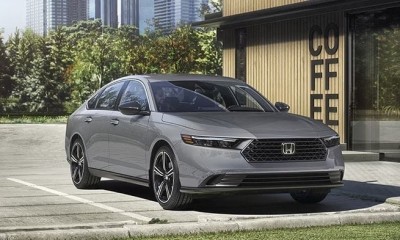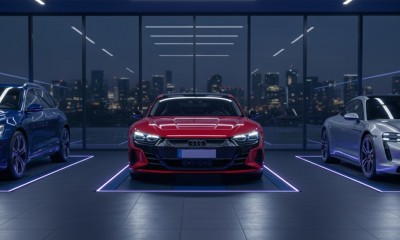FWD Explained: What Does Front-Wheel Drive Mean & Is It Bad for Performance?

Front-Wheel Drive (FWD) is the most prevalent drivetrain configuration in the modern automotive world, powering the vast majority of sedans, hatchbacks, and crossover SUVs on the road today. Its dominance is a testament to an engineering philosophy that prioritizes efficiency, interior space, and manufacturing simplicity. Yet, within the performance enthusiast community, FWD is often met with criticism, sometimes even disdain, for its perceived handling limitations. This creates a fundamental conflict: is the world's most popular drivetrain inherently "bad" for those who seek an engaging driving experience?
This report will demonstrate that this question is perhaps framed incorrectly. The performance trade-offs of FWD are not an endpoint but a starting point for significant improvement. The real question is not whether FWD is bad, but rather, "Can a drivetrain designed for practicality be engineered for high performance?" The answer is a definitive yes. This comprehensive guide will explore the fundamentals of FWD, from its technical definition and rich history to a detailed analysis of its pros and cons. Most importantly, it will reveal how the perceived flaws of FWD—the very characteristics that enthusiasts critique—can be systematically addressed and transformed through advanced, professional ECU tuning.
The Fundamentals of Front-Wheel Drive (FWD)
To understand how to enhance FWD performance, one must first grasp its core principles and historical context. The layout's journey from a niche engineering concept to the global standard was driven by a relentless pursuit of practical solutions, a theme that continues today in the world of electronic tuning.
What Does FWD Mean? A Technical Definition
What does FWD mean? FWD stands for Front-Wheel Drive. In an FWD vehicle, the engine sends all its power to the front two wheels. This layout is the most common in modern passenger cars because it combines the engine, transmission, and differential into a single compact unit, improving fuel efficiency and interior space.
Technically, an FWD system is one where the engine's power is transmitted exclusively to the front axle, making the front wheels responsible for both propulsion (pulling the car forward) and steering. The core engineering principle behind this design is twofold: first, placing the weight of the engine and transaxle directly over the drive wheels improves traction in many common driving scenarios; second, consolidating all drivetrain components at the front of the vehicle eliminates the need for a long driveshaft and rear differential, affording a more compact and space-efficient chassis layout.
A Brief History of FWD Dominance
The concept of pulling a vehicle from the front, much like a horse pulls a cart, is nearly as old as the automobile itself. Early experiments date back to Nicholas Cugnot's steam-powered carriage in 1769, with more refined patents like Walter Christie's transverse engine design emerging in 1904. However, it took decades of engineering refinement to overcome the initial challenges of this layout.
Early production models like the 1929 Cord L-29 suffered from poor weight distribution, which hampered traction and handling. The breakthrough came with the 1934 Citroën Traction Avant, which ingeniously placed the transmission ahead of the engine, dramatically improving weight balance and delivering handling that was revolutionary for its era.
The post-war era saw FWD democratized by iconic, practical vehicles. The 1948 Citroën 2CV and 1949 Saab 92 championed the layout for its efficiency and all-weather capability. But it was the 1959 Mini, designed by Sir Alec Issigonis, that perfected the formula. By mounting a compact engine transversely (sideways) and integrating the gearbox into the engine's oil sump, the Mini achieved an astonishing level of space efficiency, dedicating 80% of its floorpan to passengers and luggage. This design became the blueprint for virtually all modern FWD cars.
Throughout the 1970s and 1980s, driven by fuel crises and a demand for smaller, more economical vehicles, manufacturers across Europe and Japan, including Fiat, Ford, Honda, and Toyota, widely adopted the FWD layout, cementing its status as the industry standard. This history is not one of compromise, but of innovation. Engineers consistently identified flaws in the FWD concept and developed clever mechanical solutions to overcome them. This historical pattern of problem-solving provides a direct precedent for the role of modern electronic tuning. Just as 20th-century engineers solved mechanical packaging issues, 21st-century tuners are now solving the dynamic performance challenges inherent in the FWD platform.
The Great Debate: Is FWD Bad? A Detailed Pros & Cons Analysis
The reputation of FWD is polarized. For the average driver, its benefits are tangible and significant. For the performance enthusiast, its drawbacks can be frustrating. A balanced analysis reveals a drivetrain defined by specific, predictable trade-offs.
The Advantages of Front-Wheel Drive
The global popularity of FWD is built on a foundation of clear, practical advantages that make it the logical choice for most passenger vehicles.
-
Superior Traction in Adverse Conditions: The most cited benefit is improved traction on slippery surfaces like rain, snow, and ice. With the heavy engine and transmission situated directly over the front drive wheels, there is more downward force, which helps the tires maintain their grip when accelerating.
-
Enhanced Fuel Efficiency: FWD systems are mechanically simpler and lighter than their RWD and AWD counterparts. They lack a heavy, full-length driveshaft and a separate rear differential, which reduces the overall vehicle weight and minimizes drivetrain power loss—the parasitic loss of energy as it travels from the engine to the wheels. This translates directly to better fuel economy (MPG).
-
Increased Interior and Cargo Space: The absence of a transmission tunnel running through the center of the cabin is a defining architectural advantage. This allows for a flat rear floor, providing more legroom for passengers and increasing the flexibility and volume of the interior and cargo areas.
-
Reduced Manufacturing and Maintenance Costs: The integrated and compact nature of the FWD transaxle (transmission and differential combined) makes it less expensive to design, manufacture, and install. This cost saving is passed on to the consumer. Over the vehicle's life, the simpler design generally means fewer components to service, potentially leading to lower maintenance costs.
The Disadvantages and Performance Limitations of FWD
The very design that provides FWD its practical advantages also creates its performance challenges. The central issue is that the front wheels are tasked with two conflicting jobs: steering the car and delivering power to the pavement. This dual role can overwhelm the available grip, especially in high-power applications. Furthermore, the physics of acceleration work against the FWD layout; as a car accelerates, weight naturally transfers to the rear, lightening the front end and reducing the available traction of the drive wheels precisely when it is needed most. These principles manifest in two key handling behaviors: torque steer and understeer.
Torque Steer Explained
Torque steer is the unintended influence of engine torque on the steering system, felt as a pull to one side under heavy acceleration. It can be unsettling and requires the driver to make constant steering corrections to keep the car tracking straight. The primary cause is often the use of unequal-length driveshafts, a common necessity in transverse engine layouts. The longer driveshaft can flex or twist slightly more under load than the shorter one, resulting in a momentary imbalance in the torque delivered to each front wheel, which pulls the car to one side. Worn suspension components or engine mounts can also exacerbate this effect.
The Challenge of Understeer (Plow/Push)
Understeer is a handling condition where a vehicle turns less than the amount of steering input from the driver. When this happens, the front tires have exceeded their limit of grip and are sliding across the pavement, causing the car to "plow" or "push" wide of the intended cornering line.
FWD cars are particularly susceptible to power-on understeer. Each tire has a finite amount of grip, often visualized as a "traction circle". This grip must be divided between cornering forces (lateral grip) and acceleration/braking forces (longitudinal grip). In an FWD car, when the driver accelerates while cornering, they are asking the front tires to both steer and propel the car simultaneously. This combined demand can easily exceed the tire's total available grip, causing the front end to lose traction and push wide. This is made worse by the dynamic weight transfer that unloads the front tires during acceleration.
It is crucial to recognize that these "flaws" are not random quirks but predictable consequences of physics. Torque steer stems from mechanical asymmetry, and understeer from overloading the front tires' traction budget. Because these causes are known and quantifiable, their effects can be managed and counteracted. Automakers have developed mechanical solutions like limited-slip differentials (LSDs) and advanced suspension geometries (such as Ford's RevoKnuckle) to mitigate these forces. This establishes a key principle: FWD's handling characteristics are not immutable. They are a physics problem that can be solved with engineering—both mechanical and, as we will explore, electronic.
FWD vs. RWD vs. AWD: A Drivetrain Showdown
To fairly evaluate FWD, it must be compared to its counterparts: Rear-Wheel Drive (RWD) and All-Wheel Drive (AWD). Each layout represents a different set of engineering priorities and delivers a distinct driving experience. The choice between them is a matter of balancing performance, efficiency, cost, and capability.
The following table provides a concise comparison of the core attributes of each drivetrain layout.
|
Feature |
Front-Wheel Drive (FWD) |
Rear-Wheel Drive (RWD) |
All-Wheel Drive (AWD) |
|
Performance Handling |
Predictable, stable, prone to power-on understeer. |
Balanced weight distribution, prone to oversteer, enthusiast-focused. |
High grip, stable in all conditions, can feel heavy and complex. |
|
All-Weather Traction |
Good (engine weight over drive wheels). |
Poor (without electronic aids), can be challenging in snow/ice. |
Excellent, provides maximum grip in slippery conditions. |
|
Fuel Efficiency |
Excellent (lighter, less drivetrain loss). |
Good (less loss than AWD). |
Fair (heavier, more mechanical components, higher loss). |
|
Cost & Maintenance |
Lowest (simpler design, fewer parts). |
Moderate (more complex than FWD). |
Highest (most complex system, more parts to service). |
|
Interior Space |
Maximum (no central driveshaft tunnel). |
Compromised by driveshaft tunnel. |
Compromised by driveshaft tunnel and rear differential. |
|
Best For |
Daily commuting, fuel economy, adverse weather. |
Performance driving, track use, towing (trucks). |
Maximum safety and traction in all weather, light off-roading. |
-
Rear-Wheel Drive (RWD) separates the duties of steering and propulsion. The front wheels handle steering, while the rear wheels deliver power. This results in a more balanced weight distribution and is often preferred by enthusiasts for its dynamic handling, allowing for techniques like controlling the car's rotation with the throttle (oversteer). However, RWD typically offers less traction in slippery conditions and sacrifices some interior space for the driveshaft tunnel.
-
All-Wheel Drive (AWD) sends power to all four wheels, either continuously or on demand. This provides the best possible traction in all conditions, enhancing stability and safety. The trade-offs are increased weight, complexity, cost, and reduced fuel efficiency due to higher drivetrain losses.
In this context, FWD emerges as the master of efficiency and packaging. Its weaknesses are almost exclusively in the realm of high-performance handling, where the laws of physics begin to work against its front-heavy, dual-role tire setup. This is precisely where modern electronics can intervene.
Unlocking FWD Performance: The Role of Professional ECU Tuning
Adding significant power to a stock FWD car often exacerbates its inherent limitations, leading to uncontrollable wheelspin, severe torque steer, and aggressive understeer. Professional ECU (Engine Control Unit) remapping is the key to not just increasing power, but intelligently managing it to create a faster, more controllable, and more rewarding driving experience. A custom tuning file from a specialist like
HP Chiptuningfiles goes far beyond a generic power boost; it recalibrates the very logic of how the car delivers its torque.
Taming the Torque: Advanced Torque Management
The greatest challenge for a high-power FWD car is effectively transmitting torque to the ground. Modern ECUs offer sophisticated tools to manage this, transforming the car's behavior.
-
Gear-Dependent Torque Limiting: Traction is not constant; it is lowest in lower gears (1st and 2nd) and increases in higher gears as vehicle speed rises. A professional ECU tune can implement a gear-dependent torque strategy. The map can be calibrated to limit the maximum engine torque in 1st and 2nd gear to a level the tires can handle, preventing excessive wheelspin. As the driver shifts to 3rd gear and beyond, the tune can progressively unleash more of the engine's available torque, matching the power delivery to the available grip.
-
Custom Throttle Mapping: Factory throttle maps are often non-linear, designed to give a "sporty" feel by delivering a large amount of torque with small initial pedal movements. In a tuned FWD car, this can make the throttle feel like an on/off switch, making it difficult to modulate power when exiting a corner. A custom throttle map can be recalibrated to be more progressive and linear. This gives the driver much finer control over torque application, allowing them to feed in power smoothly and maintain traction at the limit.
This level of electronic control functions as a proactive, "virtual" limited-slip differential. A mechanical LSD reacts to wheelspin by transferring torque away from the slipping wheel. In contrast, an advanced torque management tune in the ECU works to prevent the overwhelming surge of torque that causes wheelspin in the first place. It anticipates and manages traction loss at its source, making it a powerful and highly effective strategy for taming a high-power FWD car.
Mastering the Launch: FWD Launch Control Strategies
For maximum acceleration from a standstill, a custom-tuned launch control system is essential. Factory systems are often conservative, but an expert tuner can optimize the launch sequence for a specific vehicle's power level, tires, and surface conditions. This involves:
-
Optimizing Launch RPM: Setting the ideal RPM limit to hold the engine at its peak torque for launch without causing excessive wheelspin.
-
Boost and Torque Pre-loading: For turbocharged cars, the tune can manipulate ignition timing and fuel to build boost while stationary, ensuring an explosive departure.
-
Active Slip Targeting: Advanced strategies use wheel speed sensors to actively manage torque after the clutch is released, targeting a specific percentage of wheel slip (typically 5-6%) that provides the maximum possible forward thrust.
A professionally calibrated launch control strategy, available through a custom tuning file, ensures consistent, repeatable, and brutally fast launches every time.
Tuning to Mitigate Understeer and Torque Steer
The same torque management strategies used to improve traction also directly address FWD's most criticized handling traits.
-
Reducing Torque Steer: While an ECU tune cannot alter the physical length of driveshafts, it can dramatically reduce the sensation of torque steer. By smoothing the torque curve and limiting the instantaneous peak torque in low gears, the asymmetric forces sent through the driveshafts are less violent and far more manageable for the driver.
-
Reducing Power-On Understeer: This is where a quality tune makes the biggest difference to lap times and driver confidence. By precisely managing torque delivery based on factors like steering angle, gear, and vehicle speed, the ECU can prevent the front tires from being overwhelmed during corner exit. This allows the driver to apply power earlier and more aggressively without the car pushing wide, effectively "pulling" the car out of the corner. Furthermore, a custom tune can remove factory limitations, such as throttle cut during left-foot braking, enabling advanced driving techniques that help rotate the car and combat understeer.
Conclusion: FWD Is Not Bad—It's Full of Potential
Front-Wheel Drive is an intelligent, efficient, and remarkably effective drivetrain layout that has rightfully become the global standard for passenger cars. Its reputation as "bad" among performance enthusiasts stems from a misunderstanding of its design intent. FWD was not designed to be flawed; it was designed for a different set of priorities.
For the enthusiast owner, these inherent performance limitations should not be seen as an endpoint, but as an opportunity. The predictable physics of torque steer and understeer make them susceptible to clever engineering solutions. While mechanical upgrades like limited-slip differentials and suspension components are effective, the single most transformative modification for a modern FWD car is a professional ECU remap.
By intelligently managing torque, optimizing throttle response, and tailoring power delivery to the available traction, a custom tune from a specialist like HP Chiptuningfiles addresses the core challenges of the FWD platform. It transforms a vehicle from one that struggles with power to one that uses it with precision and control. FWD is not bad; it is a platform ripe with untapped potential, waiting to be unlocked by the right code.
Ready to unlock the hidden performance in your FWD vehicle? Create an account with HP Chiptuningfiles today and explore our database of custom, dyno-tested tuning files. Let our experts help you tame the torque and master the drive. For any questions, feel free to contact our support team.
Frequently Asked Questions (FAQ)
What is torque steer in a FWD car?
Torque steer is a tendency for the steering to pull to one side during hard acceleration in a front-wheel-drive car. It's typically caused by unequal-length driveshafts delivering slightly different amounts of torque to the front wheels, creating an imbalance that influences the steering.
Are FWD cars good for track days?
Yes, FWD cars can be excellent for track days. They are often affordable, reliable, and their predictable handling makes them a safe choice for beginners. A well-prepared FWD car, especially with a proper ECU tune, performance tires, and suspension setup, can be surprisingly fast and rewarding to drive on a circuit.
Can ECU tuning really fix understeer?
While ECU tuning cannot change a car's physical suspension geometry, it can significantly reduce power-on understeer. By intelligently managing torque delivery and throttle response when exiting a corner, a custom tune prevents the front tires from being overwhelmed by too much power, allowing for earlier and harder acceleration without pushing wide.
Is it safe to tune a FWD car for more power?
Yes, when performed by a professional tuning service. A reputable company like HP Chiptuningfiles develops custom maps that operate within the safe mechanical limits of the engine and drivetrain. The key is not just adding raw power, but managing it intelligently for enhanced performance that does not compromise long-term reliability.
Other news and updates

Read more OBD Breakthrough: Tuning Support for the Continental ASG1 ECU in Audi e-tron & Porsche Taycan
The Continental ASG1 ECU used in the Audi e-tron and Porsche Taycan is now fully supported for OBD read/write. This breakthrough allows safe tuning of torque limits, current maps, thermal strategies and pedal response, enabling measurable performance gains whi...
Read more

Read more Stage 1, Stage 2, and Stage 3 Tuning: Which One Is Right for You? | HP Chiptuning Files Europe & UK
Discover the differences between Stage 1, Stage 2, and Stage 3 tuning. Learn which remap is best for your car, driving style, and budget at hp-chiptuningfiles.com.
Read more

Read more Mercedes-AMG G63 2025: ECU Remap & Performance Boost
Hey, we are HP Chiptuningfiles – Europe’s leading ECU tuning file service provider. We deliver custom, dyno-tested tuning files for diesel, petrol & hybrid engines, trusted by 4,000+ clients worldwide. The 2025 Mercedes-AMG G63 combines iconic G-Class ruggedne...
Read more